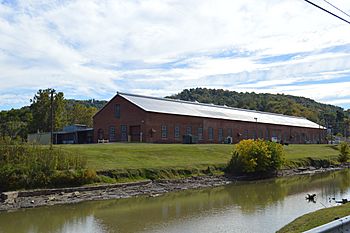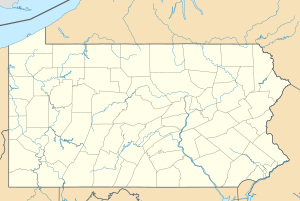Dunkard Creek facts for kids
Quick facts for kids Dunkard Creek |
|
|---|---|

Along the creek at Brave, Pennsylvania.
|
|
|
Location of Dunkard Creek mouth
|
|
| Other name(s) | Tributary to Monongahela River |
| Country | United States |
| State | Pennsylvania |
| County | Greene |
| Physical characteristics | |
| Main source | confluence of Pennsylvania Fork Dunkard Creek and White Creek Hero, Pennsylvania 1,018 ft (310 m) 39°43′17″N 080°16′13″W / 39.72139°N 80.27028°W |
| River mouth | Monongahela River about 0.25 miles east-southeast of Poland Mines, Pennsylvania 778 ft (237 m) 39°45′53″N 079°56′10″W / 39.76472°N 79.93611°W |
| Length | 42.3 mi (68.1 km) |
| Basin features | |
| Progression | generally east |
| River system | Monongahela River |
| Basin size | 233.09 square miles (603.7 km2) |
| Tributaries |
|
| Bridges | Pumpkin Run Road, Mine Road, Chestnut Street, Cliff Road, WV 7 (x4), WV 39 (x2), Hobbs Run Road, US 19, I-79, Gas Company Road, Bald Hill Church Road, Old Water Works Road, Plant Road, Bobtown Highway, Bobtown Road, PA 88 |
Dunkard Creek is a stream that flows for about 37 miles (59 km). It runs through Greene County, Pennsylvania and Monongalia County, West Virginia. You can find it near towns like Mount Morris, Pennsylvania and Blacksville, West Virginia. The creek eventually flows into the Monongahela River. This happens northwest of Point Marion, Pennsylvania. It's about three miles north of the Pennsylvania-West Virginia border.
A special place called Mason-Dixon Historical Park is located along Dunkard Creek. The creek actually crosses the state border three times in a short distance here. This park includes Brown's Hill. This was an important spot for Charles Mason and Jeremiah Dixon. They used it to make observations when they first mapped the Pennsylvania–Maryland border in 1767.
Contents
What's in a Name?
The creek got its name from a group of people called the Dunkard Brethren. They were a Christian group who settled in the area in the 1700s. They believed in peace and were known for their special way of baptism, which involved immersing people in water. The word dunke in Pennsylvania German means "to immerse." So, people who practiced this were called dunker.
The 2009 Fish Kill
In September 2009, something very sad happened to Dunkard Creek. Many fish, salamanders, and rare mussels died. This event is known as a massive fish kill. The West Virginia Department of Environmental Protection (DEP) investigated. They found that a large growth of tiny plants, called an algal bloom, caused the deaths.
Why the Algal Bloom Happened
Experts believe the algal bloom grew because of high levels of salt and a chemical called chloride in the water. A mining company, Consol Energy, had a discharge site on the creek. This site was thought to be the most likely source of this pollution. Another mine, the Shannopin Mine, also released water into Dunkard Creek.
The West Virginia DEP had known about high chloride levels since 2002. Environmental groups had asked them to act. However, no action was taken against Consol Energy before the fish kill.
Making Things Right
After the fish kill, steps were taken to fix the problem.
- In March 2011, Consol Energy made an agreement with the US Environmental Protection Agency (EPA) and West Virginia. They agreed to pay $5.5 million to help with the pollution damage. This money was for violations related to the 2009 fish kill.
- Consol also agreed to build a new water treatment system. This system would cost $200 million. It would help control pollution from their current and past mining operations in the area.
- In July 2015, Consol Energy reached another agreement. This time it was with the Pennsylvania Fish and Boat Commission. They agreed to pay $2.5 million for damages to the Pennsylvania part of Dunkard Creek. The commission plans to use this money to bring fish back to the creek. They also want to support fun activities like fishing and boating.
Restoring the Creek
Dunkard Creek is part of a large area called a watershed. This watershed covers about 235 square miles (609 km²) in Pennsylvania and West Virginia. The creek is usually a good home for fish like smallmouth bass and muskellunge. However, some parts of the creek have been badly damaged. This damage comes from something called acid mine drainage (AMD). AMD is polluted water from old mines.
The Mathews Restoration Site
In 2007, people started working to clean up a damaged part of the creek. This was thanks to a grant from the EPA. The Greene County Watershed Alliance and the Friends of Dunkard Creek led the effort. They decided to build a special cleaning system on the Mathews farm. This farm is near Poland Mines. Before this, an old mine called Maiden #1 used to dump over a million gallons of untreated AMD into the creek every day.
How the Cleaning System Works
The groups worked with experts to create a "passive treatment system." This system is like a natural filter. It uses nature to clean the water. It includes:
- Aerobic Wetlands: These are shallow areas where water flows over plants. As plants grow and break down, they create a special environment. This helps remove harmful metals from the water.
- Limestone Ponds and Channels: Limestone is a rock that can naturally reduce the acidity of AMD. When combined with the wetlands, it creates a system that cleans itself.
About 12,000 tons of limestone were used at the Mathews Restoration Site. Volunteers also planted over 2,000 plants, trees, and shrubs. This project shows how people and nature can work together. They can help bring a damaged area back to life.



